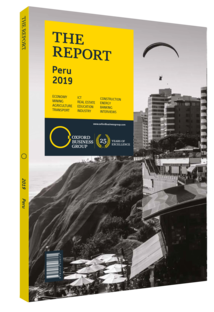Peruvian exporters stand to benefit from new industrial park strategy and mega-projects
While Peru offers a range of industrial parks, their competitiveness has been hindered by a lack of accompanying legislation and overall strategy. Although Law No. 28183 of March 2004 was promulgated in order to regulate and promote the development of industrial parks, it has not proved to be optimal in terms of achieving these objectives. “This law has not been effectively applied because the different district and municipal players have not been identified and involved,” Ysabel Segura, head of manufacturing at the Association of Exporters, told OBG. “This requires urgent change.”
Government Strategy
In order to rectify these outstanding issues the Ministry of Production announced in late 2018 that a national strategy was being formulated for the development of industrial parks. The strategy is being designed by the government body overseeing the National Plan for Productive Diversification (Plan Nacional de Diversificación Productiva, PNDP) and the UN Industrial Development Organisation.
The primary objectives of the strategy will be to mobilise resources and investment to develop industrial parks, while also harmonising legislation, in order to promote value-added industries and thereby boost Peru’s competitiveness. Additionally, the strategy will cover the positioning of industrial parks and the construction of supportive infrastructure. “Key factors that determine the success of an industrial park include location, land cost, governance and the services provided within the park’s perimeter,” Dante Carhuavilca, head of economic and social studies at the National Society of Industries, told OBG. Three types of industrial parks will be covered by the strategy: value-added parks for small and medium-sized enterprises; industrial parks for public-private partnerships (PPPs); and special economic zones. According to a press release from April 2019, a progress report on the strategy is scheduled to be released in June of the same year.
Offering
The country’s industrial parks are concentrated to the south and east of Lima, with the total land used exceeding 2400 ha in 2018, according to Colliers International. Chilca has the highest number of parks, with three located in the district and prices ranging from $100-140 per sq metre. Meanwhile, the Macrópolis industrial park in Lurín and Piura Futura in Piura have the most expensive land costs, at $160-200 and $140-185 per sq metre, respectively. According to Rodrigo Acha, assistant economic analysis manager at the American Chamber of Commerce of Peru, told OBG that industrial parks projects are growing and attracting increased investor interest. However, the continued growth of these projects face a number of challenges, notably insufficient transport infrastructure.
New Project
In January 2019 Raúl Pérez-Reyes, minister of production, announced that the technical studies for the long-awaited Ancón Industrial Park were in their final stages and would be completed by June 2019. The 1338-ha mega-project is being managed by Proinversión, the public organisation responsible for promoting private investment in public services, mainly through PPPs. According to Pérez-Reyes, a private firm will be hired in 2019 to conduct a full project evaluation and prepare the site for development. Construction is expected to begin in 2021 and to be completed by 2025. Upon completion the $380m industrial park will become the largest of its type in Peru.
The new industrial park is expected to benefit from its proximity to Chancay Port Terminal, securing access to international markets for Peruvian goods. In January 2019 it was announced that China’s state-owned shipping line, COSCO Shipping, had bought a 60% stake in the port and would invest $3bn in upgrading and expanding the port. This upgrade is set to include a new multipurpose terminal, for bulk, general and roll-on/ roll-off cargo. In addition, the port is upgrading its fishing industry infrastructure, with this earmarked for by completion by 2021. Domestic entrepreneurs in both the textiles and fish processing industries are therefore expected to benefit from the Ancón Industrial Park.
You have reached the limit of premium articles you can view for free.
Choose from the options below to purchase print or digital editions of our Reports. You can also purchase a website subscription giving you unlimited access to all of our Reports online for 12 months.
If you have already purchased this Report or have a website subscription, please login to continue.

